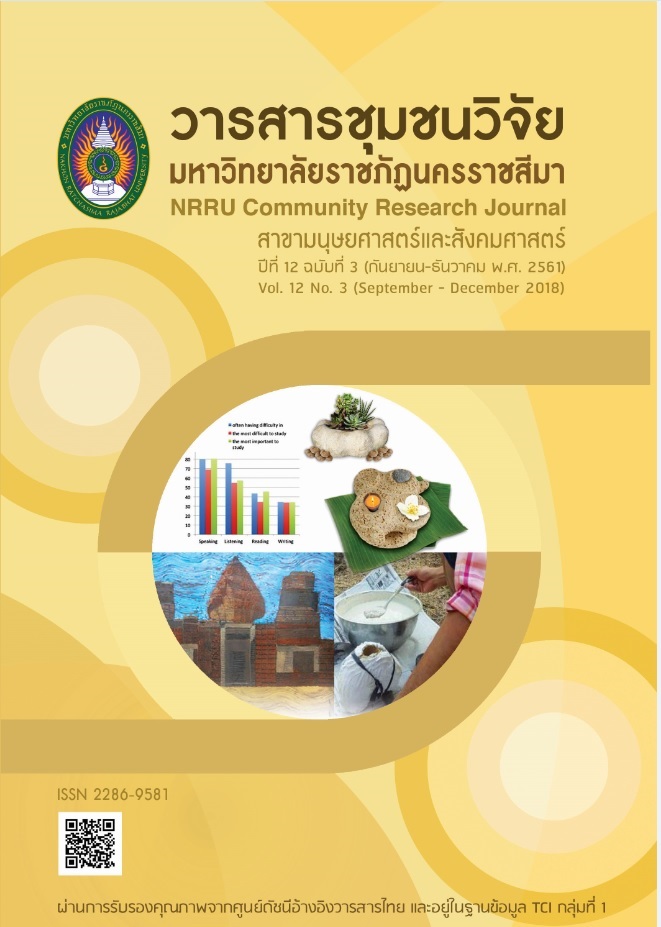การวิเคราะห์ความต้องการในการใช้ภาษาอังกฤษเพื่อการอาชีพ: การเสริมสร้างทักษะการสื่อสารภาษาอังกฤษของนักศึกษาสาขานาฏศิลป์
คำสำคัญ:
ความต้องการของผู้เรียน, การสอนภาษาอังกฤษเพื่อการอาชีพ, การสื่อสารของนักศึกษาสาขานาฏศิลป์บทคัดย่อ
การศึกษาในระดับอุดมศึกษาล้วนต่างให้ความสำคัญกับการใช้ภาษาอังกฤษเพื่อการประกอบอาชีพ เพิ่มพูนความสามารถในการใช้ภาษาอังกฤษของผู้เรียน การเรียนภาษาอังกฤษเพื่อการประกอบอาชีพจึงเป็นการเรียนรู้ที่เน้นผู้เรียนเป็นศูนย์กลางซึ่งให้ความสนใจในความต้องการของผู้เรียนเป็นหลัก รวมทั้งการรวมเนื้อหา กิจกรรมที่เกี่ยวข้องกับการใช้ในวิชาชีพ และการใช้วิธีการสอนแบบใหม่ ฉะนั้นการวิเคราะห์ หาความต้องการของผู้เรียนเป็นพื้นฐานสำคัญของการสอนภาษาอังกฤษเพื่อการประกอบอาชีพ สืบเนื่องจากความจำเป็นสำหรับในการพัฒนาภาษาอังกฤษสำหรับนาฎศิลป์ สาขานาฏศิลป์ คณะมนุษยศาสตร์และสังคมศาสตร์ มหาวิทยาลัยราชภัฏนครราชสีมา การวิจัยครั้งนี้จึงมีวัตถุประสงค์เพื่อวิเคราะห์ความต้องการของผู้เรียน ชั้นปีที่ 2 ที่ศึกษาวิชาการสื่อสารภาษาอังกฤษสำหรับนาฏศิลป์ จำนวน 78 คน ในปีการศึกษา 2559-2560 แบบสอบถามและการสัมภาษณ์ถูกใช้เป็นเครื่องมือ โดยผลงานวิจัยพบว่าทักษะที่ยากที่สุดของผู้เรียนคือการพูดและการฟังและทราบดีว่าทั้งสองทักษะเป็นทักษะที่จำเป็นที่สุดสำหรับการประกอบอาชีพในอนาคตของตนเองนอกจากนี้ผู้เรียนต้องการศึกษาเนื้อหาภาษาอังกฤษทางนาฏศิลป์โดยใช้กลยุทธ์เชิงโต้ตอบและการเรียนรู้ที่มีผู้เรียนเป็นศูนย์กลาง เพื่อพัฒนาทักษะที่ผู้เรียนต้องการ การเพื่อการสอนฟัง-พูดและกลยุทธ์การสอนที่เน้นทั้งสองทักษะจึงเป็นประโยชน์มากในการเตรียมความพร้อมของการใช้ภาษาอังกฤษเพื่อการประกอบอาชีพในอนาคตของผู้เรียนเอง
References
Benesch, S. (1996). Needs analysis and curriculum development in EAP: an Example of a critical approach. TESOL Quarterly, 30(4), 723-738.
Chostelidou, D. (2010). A needs analysis approach to ESP Syllabus Design in Greek tertiary education: a descriptive account of students’ needs. Procedia Social and Behavioral Sciences 2, 4507-4512.
Dehnad, A., Bagherzadeh, R., Bigdeli, S., Hatami, K., & Hosseini, F. (2010). Syllabus revision: a needs analysis Study. Procedia Social and Behavioral Sciences 9, 1307-1312.
Domínguez, G. A., & Rokowski, P. E. (2005). Bridging the Gap between English for Academic and Occupational Purposes. ESP World. Retrieved March 3rd, 2018, from http://www.esp-world.info/Articles_2/Bridging%20the%20gap%20between%20English%20for%20Academic%2 0and%20Occupational%20Purposes.html
Dudley-Evans, T., & St. John, M. J. (1998). Developments in English for specific Purposes. Cambridge : Cambridge University Press.
Friedenberg, J., Kennedy, D., Lomperis, A., Martin, W., & Westerfield, K. (with van Naerssen, M. (2003). Effective practices in workplace language training: Guidelines for pro- viders of workplace English language training services. Alexandria,VA : TESOL.
Hakuta, K., Butler, Y.G., & Witt, D. (2000). How long does it take English learners to attain proficiency? University of California Linguistic Minority Research Institute Policy Report 2000-1. Santa Barbara, CA: University of California-Santa Barbara. Retrieved March 12th, 2018 from http:// www.usc.edu/dept/education/CMMR /FullText/Hakuta_HOW_LONG_DOES_IT_TAKE.pdf
Hutchinson, T., & Waters, A. (1987). English for specific purposes: A learning- centered approach. Cambridge : Cambridge University Press.
Johns, A. M. & Dudley-Evans, T. (1991). English for specific purposes: International in scope, specific in purpose. TESOL Quarterly 25(2), 297-313.
Jordan, R. R. (1997). English for academic purposes: A guide and resource book for teachers. Cambridge : Cambridge University Press.
Kim, D. (2008). English for Occupational Purposes : One Language?. Continuum books Publishing. Retrieved December 11th, 2017 https://books.google.co.th/books?isbn=0826497349
Miyake, M. & Tremarco, J. (2005). Needs Analysis for Nursing Students Utilizing Questionnaires and Interviews. Kawasaki Journal of Medical Welfare 1, 23-34.
Munby, J. (1978). Communicative syllabus design. Cambridge: Cambridge University Press.
Nunan, D. (1988). The Learner-Centred Curriculum. Cambridge: Cambridge Applied Linguistics.
Phan, L. (2013). Issues surrounding English, the internationalisation of higher education and national cultural identity in Asia: A focus on Japan. Critical Studies in Education 54(2), 160- 175.
Promnath, K., & Tayjasanant, C. (2016). ASSA, P., Switching of Teachers in ESP Classes-Thai Code-English, 201(516). Retrieved November 22, 2017, from http//www.culichula.ac.th/Publication sonline/files/article/X0bKTanGxMWed110239.pdf
Richards, J. C., & Schmidt, R. (2010). Longman Dictionary of Language Teaching and Applied Linguistics (4th ed.). London : Longman.
Rodríguez, X. (2006). A English for Occupational Purposes Model Designed for Workplace. Costa Rica Cartago, Costa Rica 26-36.
Saragih, E. (2014). Designing ESP Materials for Nursing Students Based On Needs Analysis. International Journal of Linguistics 6(4), 59-70.
Ulucay, S., & Demirel, O. (2011). Perceptions of Professionals, Academicians and Current and Graduate Students on designing an ESP Curriculum for Logistics Department. Procedia Social and Behavioral Sciences 15, 794-800.
Wiriyachitra, A. (2002). English Language Teaching and Learning in Thailand in this Decade. Retrieved August 2, 2017, from Thai TESOL Focus. http:www.//apecknowledgebank.com



